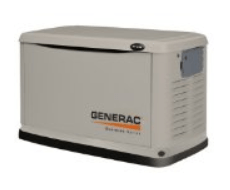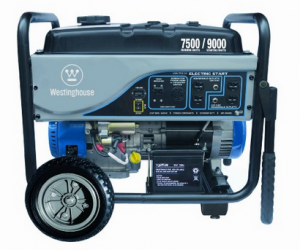Worried about power going out? Before you buy a generator . . .
The terrible snow storms this week may have prompted you to consider buying a generator. Before you do, read this . . .
By way of background, Virginia and I have played a key role in building a Community Emergency Response Team (CERT) in our neighborhood. We even have a budget from our Homeowners Association. And a couple of years ago the group agreed to purchase a gas generator to support our emergency planning team.
We originally purchased two, each of which put out 6,000+ running Watts, with 8,000 Starting Watts. On sale, each cost about $800, and was compliant with California environmental laws.
Then reality set in.
First issue: “Pounds per Watt!”

Portable generator with wheels, handles
Our big generators were deceptive. Their wheels and handlebars make them look portable. After jockeying one of them around it became painfully clear that their weight – as well as their appetite for fuel – was greater than we had foreseen. Also, they have to be started and run for 15 – 20 minutes every month or two or they will require resurrectional service (cost around $100 . . . if WE take it in to the shop).
We returned the unopened generator, and went back to the drawing board.
What had seemed like a good idea at the time turned out poorly. We kept the one generator and plan to use it to power our Command Post in an emergency. There, we’ll need it for lighting and computers and other communications. We’re still debating about purchasing any additional generators.
Second issue: Realistic output.
You probably know that a portable generators isn’t going to power your home around the clock during an extended power outage.

Standby, or permanently installed, generator
With careful management, however, an emergency generator can keep a minimum number of appliances operating in order to provide more comfort and convenience during an emergency. And with careful purchasing, you might be able to get what you need for less than $400.
For example, you can apply your power 3-4 times a day for 15-30 minutes to keep your refrigerator/freezer operating. (Exact times depend on the size of your appliance). Charging up electronic devices (laptops, tablets, cell phones, etc.) can be done at the same time since most generators have more than one plug-in socket. But plugging in an appliance that generates a lot of heat – such as a hair dryer or toaster or portable heater – may overload the generator.
Hence, managing run times and appliance combinations is required.
It’s up to you to do some homework by listing the power requirements of your various appliances, combining appliances for a reasonable total power requirement, then finding the smallest unit that will do the job.
Third issue: What fuel to choose?
Most of the portable generators for sale at your local hardware store or online will be powered by gasoline. So, consider where and how you’ll store the gas you need. Gas is easy to get most of the time (though probably not during an emergency). But gas is messy, is highly flammable, and degrades after 12 months or so.
But what about diesel, you ask? Compared to gasoline, diesel is cheaper, lasts twice as long in storage, is more fuel efficient and less dangerous. But typically you’ll need to install a storage tank to hold it. So, while some generators are set up to burn diesel, they are mostly the larger, permanently installed models that are planned to run for longer periods at higher load.
Some portable generators burn liquid propane and some can burn either propane or gasoline. Storing propane is easier than storing either gas or diesel; it can be stored in a tank or in cylinders. And propane is the cleanest burning fuel of them all. Naturally, a combo unit (running either gas or propane) is more expensive that a single-fuel generator.
You want to consider all three fuel options.
But, keep in mind that NOT ONE OF THESE MACHINES SHOULD BE RUN INSIDE! They have specific directions for their use and warnings that should be respected by all users.
Some Guidelines to Help You Make Choices.
These examples come directly from Amazon, where you’ll find literally hundreds of different generators on sale. We have picked these as having representative prices and positive customer reviews. As you shop, compare:
- delivery costs
- warranties
- environmental standards (for ex., CARB = OK to be sold in California)
Live in an apartment, condominium or modest home with access to an outside patio or small back yard, you’re looking at a small, portable unit that’s as quiet as you can find. (Propane generators are quieter than gasoline.) An example: the Champion Power Equipment 42436 1500-Watt Portable Generator, CARB Compliant costs $201.88 as of today. These items have to be shipped via ground so it may take longer than you’re used to for delivery.
Live in a Single Family Home, 3-5 Bedrooms, with outside access to patio or private yard? You can probably use a larger unit and won’t worry so much about noise or fuel storage. For about $330, you can get something like the DuroStar DS4000S 4,000 Watt 7.0 HP OHV 4-Cycle Gas Powered Portable Generator.
Large Home or Small Business that still needs to continue running, even on a reduced basis, may require something like this model. (It’s the one in the photo above, with wheels and handles that make it LOOK portable, but it weighs a good 200 pounds! ) Westinghouse WH7500E Portable Generator, 7500 Running Watts/9000 Starting Watts at $865, with free scheduled shipping.
Medium-Size Business that cannot afford to shut down for any sustained period, you’re looking at what’s called a “standby” generator. These are installed permanently and go on automatically even if you’re not there. This example (shown in photo above.) runs on propane or can be connected to a natural gas supply (probably not the best idea if you live in earthquake country). Cost: $2,549 with extra $20 for shipping.Generac 6439 11,000 Watt Air-Cooled Steel Enclosure Liquid Propane/Natural Gas Powered Standby Generator (CARB Compliant) without Transfer Switch
This should be enough to get you started on some sensible shopping!
Joe Krueger
Your Emergency Plan Guide team
Looking for a bit more background? Here are a couple of Virginia’s recent posts:
- For more on alternatives for emergency power, including solar as well as generators, https://emergencyplanguide.org/choices-for-emergency-power/
- For a list of common appliances, to help build a “use schedule” for your generator, check out: https://emergencyplanguide.org/when-less-is-more/

